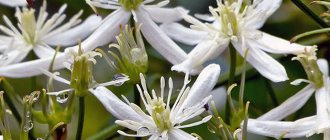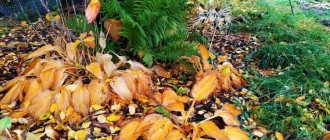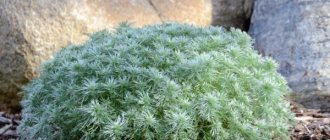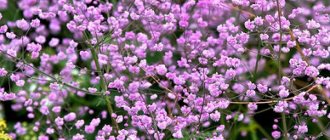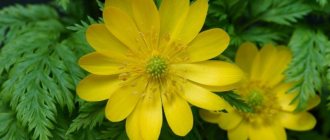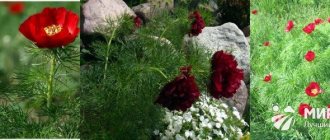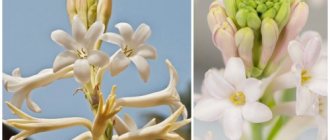09/17/2019 Michur Ivanov Garden and vegetable garden If you have a plot of land with poor and acidic soil, do not be upset, because even on such lands you can grow beautiful plants. Designs can be made using heather due to the wide variety of varieties. Let's talk in more detail about planting and caring for heather in open ground with photo examples, types and varieties of plants, as well as when to plant it in the fall.
Popular varieties of heather
The plant is divided into several large groups, which differ in the height of the bushes:
- Large ones. This is a tall coniferous heather that grows up to 70-80 centimeters in height. Large bushes are used to create flower arrangements in which tall and short flowers are adjacent to each other. The most popular large varieties are Allegro and Long White.
- Medium height. An ordinary shrub, the height of which does not exceed forty centimeters. Medium-sized seedlings are used to design a monochrome garden. Most often, Aurea, Boskop and Carmen are planted in the garden.
- Dwarf. A low-growing flower that grows to only 25-30 centimeters. Popular dwarf flowers are Silver Knight and Red Star.
We distribute varieties at the planting site
By dividing into several groups you can get a beautiful flowering meadow.
If you are going to plant more than one heather bush, first distribute them into groups. Depending on the height of the selected variety, we plant heathers at a distance of 20 to 30 cm from each other.
Do not mix different species and varieties, alternating them one after another; on the contrary, plant several bushes of the same type together. When the plants grow, you will get uniform “spots” and transitions to a different color and variety.
Heather in garden design
People who grow heather in their country houses often use it to decorate their gardens. Experts recommend planting it in shaded and dark parts of the site, as its flowers can lighten them. In this case, it is necessary to plant them not one at a time, but 10-15 at a time. Many consider the creation of a heather garden to be the most successful design solution. At the same time, not only heather bushes are planted on the site, but also Erica. Despite the fact that these plants bloom at different times, they go well together.
Diseases and pests
Due to its natural resistance to diseases and parasites, heather rarely gets sick. The main diseases of the plant are fungal infections that appear due to waterlogging of the soil. As a rule, heather is affected by rust, late blight and gray rot. It is possible to identify one or another disease by its external qualities:
- the appearance of rust is distinguished by the appearance of red-brown spots on foliage and shoots;
- with late blight, the above-ground part of the heather “turns gray”, becoming covered with a diseased whitish coating;
- With gray rot, the leaves of the plant quickly die and fall off.
As a result of identifying undesirable manifestations, the heath is immediately sprayed with industrial preparations (“Topaz”, “Fundazol”, “Oxychom”). The treatment is carried out three times, maintaining a gap of a week and a half between operations.
In case you suddenly saw that the leaves of the heather suddenly began to become deformed, and single flowers acquired an unnatural color, then, most likely, a pathogenic virus was thrown into your area. Infected bushes need to be dug up and burned, since viral diseases of plantings are incurable.
Conditions for growing crops in an open area
To grow heather, you need to become familiar with the optimal conditions for its cultivation.
Lighting and location selection
Before planting heather in the garden, you will have to find a suitable place for growing it. Many people believe that this plant is unpretentious in care and therefore grows anywhere, but this is not so. The flower is undemanding to lighting, and therefore it can be planted in shaded areas that are not always illuminated by the sun. When choosing a suitable place in the garden, pay attention to how it is blown by the wind.
The site must be reliably protected from wind gusts so that the seedlings do not break from strong winds.
Optimal temperature
The plant has poor frost resistance and therefore it is better to understand in advance the optimal temperatures for growing it. People who have been growing heather for many years recommend growing it in winter at temperatures of about 5-10 degrees Celsius.
To protect the bushes from hypothermia, the soil is mulched at the end of autumn.
The optimal temperature in summer is considered to be values that do not exceed twenty degrees above zero. Growing flowers near heat sources is contraindicated, since hot and dry air negatively affects growth and flowering.
Humidity
In order for the planted heather to grow and develop well, you need to monitor the level of humidity. In this case, special attention is paid to soil moisture. This is a moisture-loving plant that needs to be watered often. If the soil is too dry, the bush will begin to dry out. You also need to monitor air humidity. It is known that dry air negatively affects flower growth. Therefore, care must be taken to ensure that the air humidity is 80-90%.
See also
Rules for planting and propagating pink snowberry, secrets of careRead
Suitable soil
Experts advise planting heather in soils with a high level of acidity. If the acidity is too high, it is reduced with citric acid, peat or sulfur. You cannot grow bushes in alkaline soil, as they will quickly die.
The growth and development of heather is facilitated by micronutrients that should be contained in the soil. In order for the planted bushes to grow better, sand with peat and sawdust are added to the ground. You can also add 60-70 grams of sulfur to each plant, which accelerates the growth of heather.
The best and worst neighbors
People who have never grown heather are interested in which plants are best to plant it with. All varieties of northern orchids are considered good neighbors. If you plant them together with heather bushes, they will begin to bloom several weeks earlier than usual. Moreover, they will bloom 5-8 days longer. They can also be planted near pulmonary gentians, which bloom in early summer. Such flowers are considered tall, and therefore they should grow behind the heather.
Vegetable crops are considered bad neighbors because they consume a lot of nutritional components and slow down the growth of flowers.
Choosing a landing site
We determine the seat.
The illustration for the article is used under a standard license ©sadvokrug.ru Heather is planted throughout the year, only avoiding frost periods. All an evergreen plant needs is a space of 30 cm. If you plant it in a flower pot, then choose a container with a depth of at least 20 centimeters.
For planting, choose a sunny, warm place, without direct sunlight, but partial shade is also suitable for planting.
The plant grows well at the foot of both coniferous and deciduous trees.
Heather requires acid-neutral soil (not limestone!). Grows well in light, well-drained dry soil, and some species prefer moist soil (peat bogs).
Tip: Since heather is decorative not only for its flowers and their variety of colors, but also for its foliage, which changes its tone in winter, plant several different types of plants nearby and the appearance of the area will change colors, moving from season to season.
On a note! After flowering, gardeners recommend trimming heathers with garden pruners or scissors to stimulate vegetation and maintain clumps of shrubs in the correct shape.
Methods of planting and propagation of crops
There are four methods of flower propagation, the features of which should be familiarized in advance.
Bends
Many gardeners decide to plant heather using offsets. To do this, you need to dig a shallow hole near one of the bushes, then free one of the lower branches from the leaves and dig it into the hole.
You can secure the branch using regular wire or a strong metal pin. The upper part of the branch must be lifted and tied to the support.
When the shoot is dug into the ground, it should be watered with warm water. After a few weeks, the branch will be completely rooted, and it can be cut from the parent bush and transplanted to another place.
Apical cuttings
Another common propagation method is planting apical cuttings. They are cut from old and already woody branches of the plant in the twentieth of August. For planting, branches that do not have flowering shoots are cut off. Cut branches must be planted in containers with a soil mixture prepared from soil and peat. After planting, they are thoroughly watered and fed with superphosphate and urea.
Seedlings
Some gardeners prefer to propagate heather with rooted seedlings. This is done in the spring, but sometimes they are planted in early autumn. To plant, you need to buy seedlings in specialized stores that sell flowers. Before planting, all seedlings must have their roots straightened out so that they are not bunched together.
If this is not done, the planted seedlings will not be accepted well and will die. The plant should be planted in a shallow hole 10-12 centimeters wide. First, warm water is poured into it, after which the plant is planted.
Dividing rhizomes
This method of propagating seedlings is carried out at the end of summer, two weeks before the beginning of September. First you need to carefully dig up the bush and remove it from the ground. Then all drying shoots are cut out from the dug plant and the rhizomes are divided into parts. The separated roots are planted in dug holes and watered.
Optimal timing for planting and transplanting crops
Before planting flowers, you will have to figure out the optimal timing for planting them in the garden. Experts recommend sowing in the spring, when the air warms up to 10-15 degrees. Therefore, gardeners most often plant heather in the second half of April or May. Some people decide to plant in the fall. The most suitable time for this is October and the end of September.
See also
Planting and caring for rhododendrons in the Urals, preparing for winterRead
Description of the plant
Common heather (Calluna vulgaris) is a small evergreen perennial shrub without a main trunk.
All shoots are woody and erect, strongly branched, with small triangular leaves without petioles, arranged in four rows. Inflorescences are racemes up to 25 cm. With white flowers from 5 to 30 pieces, less often pink, red and even purple, up to 1 cm in size, with an actinomorphic perianth and four petals. In autumn the fruits appear - dry brown boxes. Heather is an oligotroph, so it can live even in the poorest soils with a low nutrient content. Winter-hardy. A wonderful honey plant. Propagated by seeds.
The plant is xerophytic and adapted to life in arid areas. The possibility of its habitat on moist soils becomes real due to evaporation and accompanying cooling. This phenomenon is called “physiological dryness,” in which the plant extracts more water from cold, moisture-saturated soil than from dry soil.
Heather grows in symbiosis with protozoan fungi that form mycorrhiza. With the help of hyphae, mycelium threads, it can obtain food even in the poorest soils. Therefore, if you try to bring it home from the forest, you need to save the root ball.
The lifespan of heather is 30 years or more. Annual growth is from 1.5 to 2 cm per year. It blooms profusely for two months - July and August. Flowering begins at 5–7 years.
Heather seeds are characterized by aboveground germination. During the first year, a small shoot grows with leaves that grow more crowded in its upper part. Many young heathers can be seen in open sandy areas, close to fruit-bearing plants.
Under natural conditions, in aging plants, the main stem and side branches begin to gradually lie down and take root. Since the length of each of them is at least one meter, a curtain is formed near the shrub, the diameter of which can reach up to three meters. As soon as the lying stems have enough adventitious roots, they become fragile. When the stems break, they separate from the mother bush and continue to grow as independent plants.
Heather care depending on the time of year
In order for heather to grow well and bloom for a long time, it must be properly cared for.
Watering and loosening the soil
This is a moisture-loving flower that needs abundant watering. If you do not regularly moisten the soil, the heather bushes will not develop well. To moisten the soil, you must use acidified warm water. Therefore, before watering, it is mixed with citric acid or apple cider vinegar.
In spring, flowers are watered at least once every 7-10 days. In hot summers, the procedure is carried out every three days.
Fertilizer application
To ensure abundant flowering and improve the development of seedlings, special fertilizers are added to the soil. Heather does not need to be fed very often; once a season is enough. The best food for a flower is a nutrient solution made from bird droppings diluted in water. It should be used at the end of May or June. You need to water the bushes carefully so that the fertilizing liquid does not accidentally get on the surface of the leaves.
Diseases and pests: prevention and treatment
Heather bushes are known for their resistance to common fungal and viral diseases. However, despite this, sometimes they can get sick. Most often this happens due to improper care of the bushes or planting in contaminated soil. To treat and prevent the development of diseases, seedlings must be periodically treated with fungicides and chemicals.
Pruning and replanting
To prevent premature aging of the bush, it is necessary to periodically prune it. The procedure is carried out in September or October, when flowering completely ends. All leafy shoots of the plant are pruned. First of all, the shoots on which yellow leaves appear are removed. It is also necessary to cut off stems whose length exceeds ten centimeters.
Heather seedlings need to be replanted to another location once every five years.
Heather after flowering: how to care
When the plant has flowered, you need to make sure that it has enough nutrients for the winter. To do this, the bushes are fed with organic and mineral fertilizers. The plant is fed with manure, peat and a solution made from bird droppings and leaf humus. Also, potassium-containing and nitrogen-containing fertilizers must be added to the soil.
Growing and care
Heather does not require care, but by paying a little attention to it, you will get a wonderful garden decoration that will delight you with its bright flowers.
Watering and fertilizing
The plant does not require a lot of water. The exception is days when the weather is hot. The soil around the bushes can be thoroughly watered once a week. Rainwater is ideal for irrigation. You should not overwater the plants, as stagnation of moisture leads to the formation of mold and fungi, as a result of which the plants will simply die.
As for feeding, fertilizing heather is not a mandatory activity. However, if the leaves have lost their natural color and become faded, it is advisable to use fertilizer for rhododendrons. In this case, fertilizing is usually done at the end of winter or spring.
You should not use universal fertilizers for heather, especially if they contain calcium.
After feeding, the plantings are well watered, and the use of hard tap water is avoided.
The nuances of preparing plants for winter depending on the region
In order for the plant to survive the winter normally, it must be prepared for wintering in advance.
In the Urals and Siberia
People who grow heather in Siberia and the Urals must prepare it for winter frosts. Preparation begins in early autumn, before severe cold begins.
If you start preparing too late, the plant will not survive the winter.
To ensure that wintering goes smoothly, the surface of the soil near the bushes is covered with pine branches and sawdust.
In the middle zone and Moscow region
The climatic conditions of the Moscow region and the middle zone are ideal for heather seedlings. However, even when growing flowers in these regions, they must be prepared for wintering. Before frost, they are covered with dried grass, fallen leaves or tree branches.
In the Volga region
Seedlings grown in the Volga region also need to be covered for additional protection from frost. You can cover them with plastic wrap, dry branches, hay, straw or leaves.
Choosing a place for heather
In order for the plant to feel its best, it needs to create conditions that are as close to natural as possible. It is advisable to choose a place for planting such that during the day the plant is in the shade of trees, and in the morning and evening it basks in the mild sun. In an open area, the heather will not disappear, but the flowers will be small and the flowering will not last long.
It is not worth planting heather in absolute shade, since it may not bloom at all.
If your site has a swampy lowland, then when arranging a decorative corner, do not forget about drainage. The plant prefers moist, but not wet soil. If there is too much moisture, it will simply disappear. In dry areas, on the contrary, heather will feel good, but it will not be possible to obtain a lush crown, and after a few years the buds will stop forming altogether.
Features of growing in the Moscow region
Which variety to choose
Breeders have developed many varieties of this plant. About 50 varieties are currently common in Russia. The following frost-resistant heather varieties are suitable for growing in the Moscow region:
- Allegro is the most popular in European countries. The height of the shoots is 50 cm, the width of the crown is no more than 60 cm. The leaf is narrow and dark green. The flowers are deep dark red in color and are collected in very long inflorescences. Flowering lasts from August to October. It grows rapidly, up to 2-3 cm annually.
- Annemarie is one of the most spectacular. The plant is 40-50 cm high, no more than 60 cm wide. Dark green leaves change color to brown in winter, and gray-green in spring. A special feature of the variety is the ability to bloom very beautiful dark pink double flowers from purple-red buds. Blooms from August to October.
- Long White is a tall plant, with a bush height of 60-70 cm. The leaves are a juicy bright green color. The crown has a spherical shape of medium density. It is considered a late bloomer and blooms from October to November with simple white flowers collected in inflorescences 10-20 cm long. Good for cutting into winter bouquets.
- Hamilton is an old and very valuable variety. The bush does not exceed 25 cm in height and has a cushion-shaped, compact and dense crown. The leaves are green in summer, brick red in winter. Flowering time is September-October. Double flowers of an unusual salmon-pink-apricot hue.
Medicinal properties of heather
If you buy a heather plant correctly, plant it correctly and care for it, following the recommendations of practicing gardeners, you can get a real picturesque carpet of heather on your own plot, so attractive with its appearance and aroma.
The smell of blooming heather will certainly attract bees to your garden, which will pollinate not only this plant, but also others, thus stimulating the flowering of the entire estate!
Heather looks spectacular in the company of dwarf conifers and goes well with flowering shrubs. As a rule, it is planted in front of taller plants.
Don’t be upset if you get a dacha plot on poor acidified soils. To design the area, use heather; planting and care will allow you to get wonderful decorative thickets that give the dacha a magical, mysterious atmosphere. At the beginning of summer, the flowerbed takes on an autumn color: among the shrubs covered with dark green foliage there are specimens with white, yellowish and orange leaves covering low bushes.
In July, the air is filled with an intoxicating aroma, and clusters of white, pink, and purple flowers bloom on the branches. Growing this evergreen shrub is possible even in areas where owners come only on weekends.
Propagation of heather by seeds
Heather is propagated using seeds at home, for example, in bags, without planting it in the soil. The seeds are covered with glass until germination. The most suitable substrate for cultivation is peat, coniferous or heather soil and sand in proportions of 2:1:1. The optimal temperature for germination is 18-20°C.
30 days after sowing, the seedlings should sprout. In the first week from this point on, you should maintain a high level of humidity. In the summer, seedlings in boxes need to be taken out into the garden, grown, and hardened off. When one and a half to two years have passed, you can plant the plants in a stable place.
How to grow heather?
In the Moscow region, planting heather and caring for the crop in open ground is based on providing proper lighting, watering and fertilizer. How to care for heather in the garden? Their cultivation requires regular watering.
Ordinary seasonal heather feels excellent in open ground. Planting and caring for it are standard. The substrate should be constantly moist, but at a moderate level.
Heather in the garden does not like excess water, this can lead to fungal diseases and mold.
When watering, be careful not to spray the leaves and outer parts of the plants.
This is important because excess water is the most common cause of gray mold.
Planting and caring for common heather in open ground is not much different from the procedure used for other species. These plants require regular feeding, at least twice a season. The correct soil pH should be maintained. Multicomponent fertilizer promotes flowering and makes plants more lush.
Trimming
Planting and caring for various types of heather in the open ground, for example, Erica, is practically no different. Growing the crop should be based on regular pruning and bush formation. Heather in the garden grows very quickly and can begin to compete for space. For this reason, pruning should be done once a year, in the spring.
At home, heather grows much less intensively. This is often limited by the size of the pot. For this reason, it is worth replanting them once a year and then every two years into larger containers. Thanks to this, the plants will grow freely.
Preparing for winter
Heather is not very demanding, but it is advisable to protect it in winter. There's nothing complicated about it. All you need are branches of coniferous trees.
Important: Avoid foil, leaves or straw as this can cause the heather to rot.
After the first frost, the heather can be covered with agrotextiles.
Planting with other crops
The best company for heather is plants that together with it form a multi-colored ensemble. Such a community of crops in the garden can be perfectly complemented by low coniferous trees.
Japanese azaleas are also worth considering when choosing the right company for the flowers in question.
Growing the plants will not be a problem because they not only fit together beautifully, but also have similar growing and care requirements.



